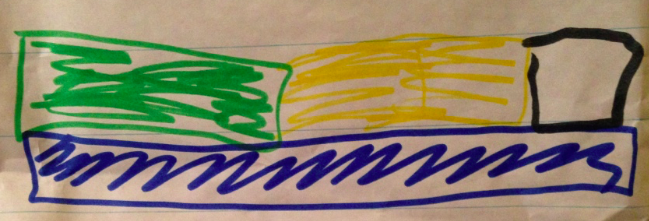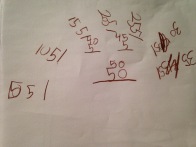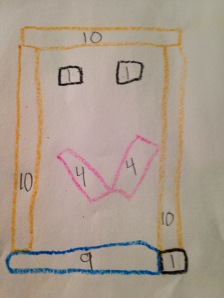For the last few weeks, I have visited a third grade classroom every afternoon. I love this time because I get to work with a teacher for whom I have a tremendous amount of respect. I wrote about her here.
This teacher has often told me how much she loves to teach math. She has been teaching for thirty years and she is always growing and learning. She often comments about how much her math instruction has changed over the last ten years. She has become an expert at honoring student thinking, valuing mistakes as learning opportunities, and cultivating perseverance. She told me in the beginning of the year that she was worried about math this year. She has a group of students who have so many social and emotional struggles in their lives that she is not sure how she will be able to get them to build their stamina for problem solving. She invited me into her classroom and I was honored to accept.
Admitedly, I was nervous. I am great at “talking the talk” when it comes to teaching kids how to persevere and communicate their reasoning, but “walking the walk” is really hard. This teacher “walks the walk” so well and she does it with patience and love. I knew I would be learning from her, but I was not sure that I would be bringing anything new to the table.
Awhile ago, I had read about the Hundreds Face challenge and thought, “That is so cool. I am going to try that with kids.” Then, I filed the idea with the thousands of other amazing ideas that I have seen on Twitter and WordPress in the short 6 months that I have been spiraling through the MathTwitterBlogoshpere. The beauty of the #MTBOS is that, yesterday, I found myself reading Malke Rosenfeld’s post, #HundredFace Round 2 and thinking, “Oh yeah. I remember that. That is so cool. I am going to try that TODAY with the third grade class that is struggling to persevere.”
I was still nervous. What if they didn’t get it? What if they gave up? What if they didn’t want to make faces? Should I let them build other things? If I did, what would the constraint be? I decided to ask Malke for her thoughts. Here is another beautiful thing about the #MTBOS – you can ask far away people for help. At 10:31, I posted some questions on Malke’s blog. At 11:56, Malke responded with some suggestions and a few more questions. At 12:30, I responded with my new ideas. At 1:15, I taught the lesson.
Stop for a second and think about what I just said. Now, think about this: I have never met Malke. This was the first time that we ever communicated.
When I got to third grade, I told the third grade teacher my idea. She was thrilled. “That is a great idea!” she said. Then, she took out her giant tote of Cuisinaire rods. As the kids came in and got settled, I caught her up to speed about what Malke and I had discussed. We anticipated what students would do and what we would look for to share with the whole group.
First, we took a page from Malke’s book and told the kids to explore with the rods. We smiled as we saw several kids building stairs and then noticing that they could compose rods out of other rods. They told us that 10 whites equals 1 orange. Here are some of the other equivalent compositions that they built:


Next, I told them about the challenge. Malke, the teacher, and I had all agreed that starting with 50, instead of 100, would offer scaffolding without lowering the cognitive demand of the task.
All of the kids started building faces. Most of them were thinking about how to make the face equivalent to 50 white cubes. At this point, the third grade teacher and I agreed that our priority was to encourage students to stick with the task for as long as they could. It was okay if some of the faces didn’t equal 50. We could come back to the faces next week and explore the math more deeply. Here are some of the 50 faces:
The one on the right is one of my favorites. When I first approached the student, I asked him how he knew that the face was worth 50? He wrote, “blues are 9 so I need 5 ones.” I don’t know if you can tell from his picture, but he used 4 blues to outline the face, 1 blue for the mouth, and then he tacked on a white cube to the end of the mouth.
Some of the kids were struggling with making a face that was equal to 50 and some of the kids were done and ready for more. The teacher and I conferenced and decided to offer a choice for the next challenge:
- Choice 1: Build a face that is equivalent to 100!
- Choice 2: Design your own face and tell us how much it is worth.
We weren’t sure if the second choice would offer enough of a constraint, but we think it did. The students who chose to design their own face were constrained by justifying the value of the face they had created. The additional constraint of defining a value was beyond their zone.
Here is a sample of two students who designed their own face and told us the value.
And here are some of the #Hundredfaces:
There are still some faces that we need to revisit next week. I love these faces, even if the math is a little off:
The best part of this lesson was at the end. We asked the students what they learned today. Here is what they said:
- “Math can be fun!”
- “Never give up! You’ll never figure your way through it and you won’t learn if you give up.”
- “We made a bunch of mistakes today so our brains must have grown.”
- “Keep going – it’s a challenge.” (This one is from the boy who looked up at me half way through the lesson and said, with a big grin on his face, “This is so much harder than I thought it would be.”
And my favorite one…
“I learned to keep trying. I was trying to make a face with only 50 and I kept getting over 50 ,and over 50, and 0ver 50. I just kept trying the 50 face. Then, I got 50. Now, I am trying to build the 100 face.”
Thanks Malke.

















